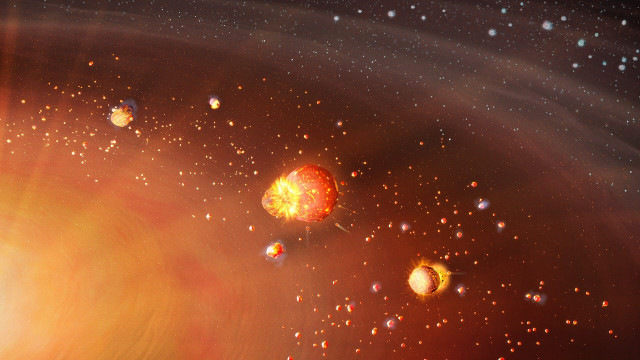
An article published in the journal “Science” reports a study that offers an explanation for the structure of the solar system with the different characteristics of the inner rocky planets and the outer gas planets. A team of researchers led by Dr. Tim Lichtenberg of the British University of Oxford put together information on other star systems in their formation phase and on the contents of meteorites to create simulations of the origin of the solar system. The conclusion is that it occurred in two phases, first the rocky planets and then the gas planets.
The basic processes of the solar system formation are known, through theoretical work and the observation of protoplanetary disks possible today. About 4.5 billion years ago, larger and larger fragments began to form in a disk of gas and dust thanks to their progressive accretion. However, the details are still being analyzed, and this study offers an explanation for some events that led to the formation of the solar system with inner rocky planets and outer gas planets.
The intuition that led to this study came by combining the reconstruction of the process of formation of planetesimals, large asteroids composed of rocks and water ice that constitute an intermediate phase in the planetary formation process, and the data collected on the different chemical composition of the internal and external solar system, also by studying the content of meteorites.
According to the reconstruction done by Dr. Tim Lichtenberg’s team, the inner rocky planets started forming first, when the Sun itself was still forming. The outer planets started forming about half a million later, a very short time in astronomical terms, yet crucial.
The radioactive elements present in the forming solar system were crucial according to this reconstruction. These elements decay over time generating a heating that, in the inner planets, caused a melting process that formed iron cores and the loss of volatile materials. The consequence is that rocky planets were originally arid. The outer planets contained fewer elements that were still radioactive, especially elements that decay rapidly such as aluminum-26, so their cores didn’t heat up that much, and that limited the formation of an iron core and the loss of volatile materials.
Another difference between the two types of planets in the solar system is that the rocky ones grew slowly while the gaseous ones grew rapidly. According to the reconstruction, that’s due to the so-called snowline, the boundary between the area of the accretion disk where water is frozen and the one where the star’s emissions keep it in a gaseous state.
The image (Courtesy Mark A Garlick/markgarlick.com. All rights reserved) shows an artistic representation of the formation of the two planetary populations. The inner protoplanets are shown in the foreground, the outer ones in light blue are in the background.
This study can also be useful to examin other star systems. Advances in this field, with the continuous discovery of exoplanets and systems in various stages of formation, will allow to test the conclusions of Tim Lichtenberg’s team. Understanding the evolution of rocky planets also means reconstructing the evolution of their atmosphere to identify the best candidates to host life forms similar to the Earth’s.

